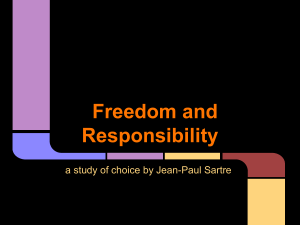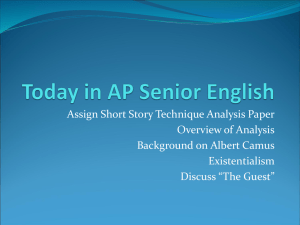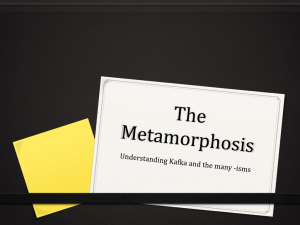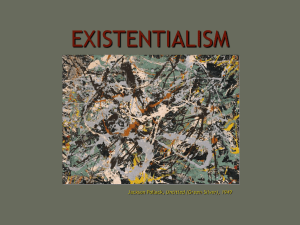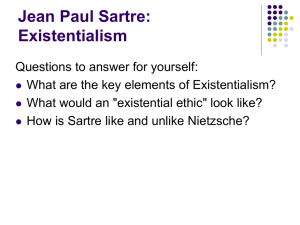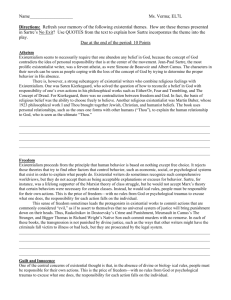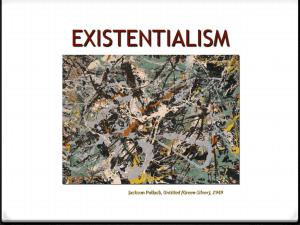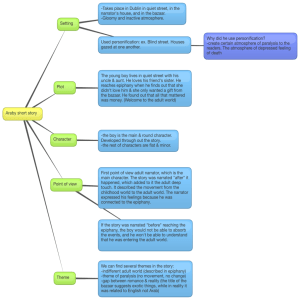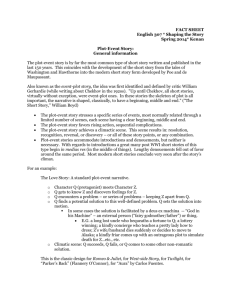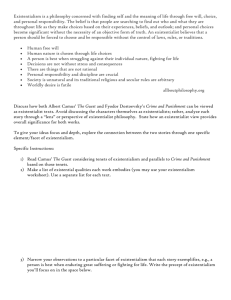AP Literature 2015-16 Dr. Jamir SEMESTER I/MIDTERM
advertisement
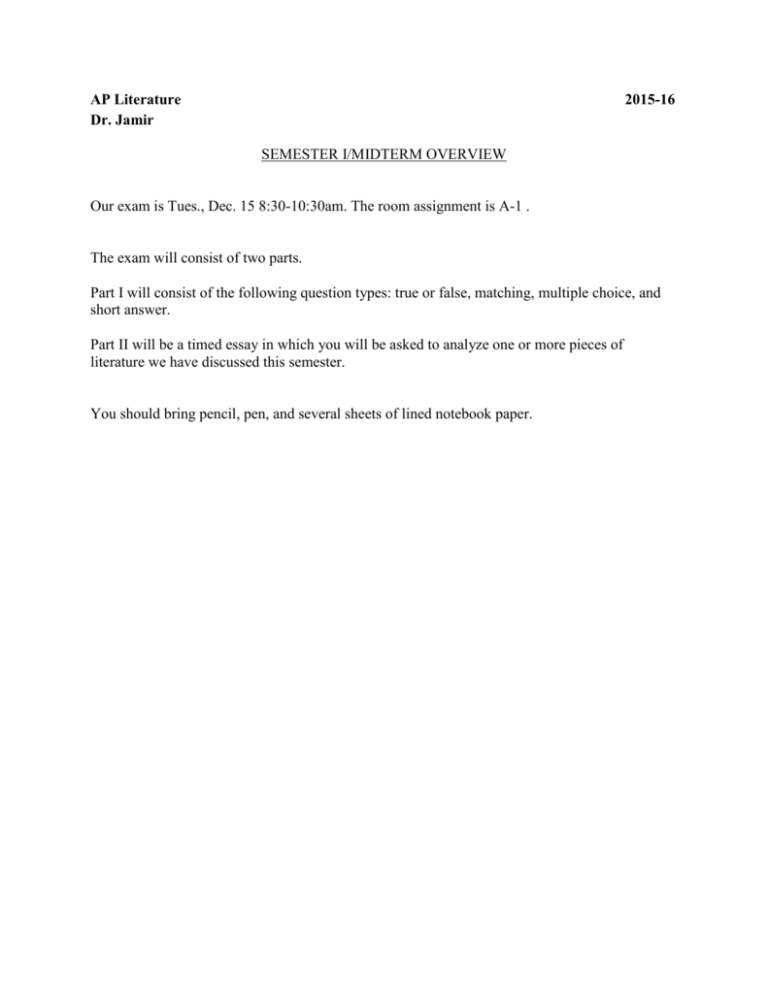
AP Literature Dr. Jamir 2015-16 SEMESTER I/MIDTERM OVERVIEW Our exam is Tues., Dec. 15 8:30-10:30am. The room assignment is A-1 . The exam will consist of two parts. Part I will consist of the following question types: true or false, matching, multiple choice, and short answer. Part II will be a timed essay in which you will be asked to analyze one or more pieces of literature we have discussed this semester. You should bring pencil, pen, and several sheets of lined notebook paper. AP Literature Dr. Jamir 2015-16 MODERNISM & POSTMODERNISM GUIDE Books, stories, poems Slaughterhouse-Five by Kurt Vonnegut *See the PPT posted to Aug. 24. “Sailing to Byzantium,” “The Second Coming,” and “Leda and the Swan” by W.B. Yeats “The Love Song of J. Alfred Prufrock” and The Waste Land by T.S. Eliot (*For Eliot’s work, see the links posted to Sept. 8 and 9.) “Sunday Morning” by Wallace Stevens “The Red Wheelbarrow” and “Spring and all” by William Carlos Williams “Araby” by James Joyce “Hills Like White Elephants” by Ernest Hemingway “Babylon Revisited” by F. Scott Fitzgerald “Miss Brill” by Katherine Mansfield Key Concepts for Modernism Subjectivity Impressionism Disillusionment (following WWI) Industrialization and technological advancement Urbanization Chaos/disorder the Victorian Era *See the PPT posted to Sept. 14. Key Concepts for Postmodernism Self-reflexivity (metafiction) Parody Pastiche Eclectic approach Genre play Unique visual formatting *See the PPT posted to Aug. 17. James Joyce and epiphany In literature, an epiphany occurs at the end of a piece. The epiphany belongs to the main characters. The content of an epiphany is a start realization (and one might say instead revelation), usually that the world is not operating properly or well. The language of an epiphany is often formal and/or eloquent. Joyce writes, “Its soul, its whatness, leaps to us from the vestment of its appearance. The soul of the commonest object, the structure of which is so adjusted, seems to us radiant. The object achieves its epiphany.” -Joyce, The Portrait of the Artist as a Young Man AP Literature Dr. Jamir 2015-16 EXISTENTIALISM GUIDE Books, stories, films, and scholarship No Exit and The Flies by Sartre “The Guest” by Camus The Metamorphosis by Kafka “The Myth of Sisyphus” and “An Absurd Reasoning: Absurdity and Suicide” by Camus “Existentialism Is Humanism” by Sartre The Road to Freedom (documentary on Sartre)- BBC, 1999 Historical figures & texts Jean-Paul Sartre (French)- 1905-80; modern atheistic existentialism; introduced the term existentialism; Le Nausee (1938) Albert Camus (French)- 1913-60; The Myth of Sisyphus (1942) Key concepts for books and stories Sight/seeing Physical appearance Gender Guilt Imprisonment/being stuck or trapped Strangers (or *others) Memory Mystery Communication Family The supernatural/otherworldiness Death Change or transformation Key concepts for existentialism essence existence existence precedes essence! void/muck (le neant and le visqueux, respectively) angst/nausea/dread passive vs. active choice existence the system (conforming to) Formal traits Characters in No Exit Biblical allusions Postmodernism Retelling (Greek myth), fragmentation Garcin Inez Estelle the valet Characters in The Flies Zeus (and fake name) Orestes (and fake name) Electra Aegisthus Clytemnestra The three furies The flies Settings Hell Argos Algeria Paris Characters in The Metamorphosis Gregor Samsa Grete Samsa Mr. Samsa Mrs. Samsa The chief clerk The three boarders AP Literature Dr. Jamir 2015-16 THE SOUND AND THE FURY GUIDE *PPT on Modern Southern Lit. posted to Oct. 26. Characters Quentin Compson Candace/Caddy C. Jason C. Benjy C. Jason C. IV Jason C. III Caroline Compson (née Bascomb) Uncle Maury Damuddy Dilsey Roskus Versh Luster T.P. Frony Dalton Ames S. Herbert Head “little sister” Shreve Deacon Gerald Julio Earl Uncle Job Lorraine Miss Quentin Man with the red tie Key Concepts Family Community Identity Gender Sexuality/Sex Sin Economic status/money Ethnicity/race Power/control Loyalty Time Communication Memory Storytelling Secrets Escape Luck Symbols Settings Golf course and balls Red flag and tie Fire Fence and gate Jackson Trees (and other plants and flowers, e.g. honeysuckle) *Benjy likes to hold a flower. Water Glass Mirrors Shadows Bridge Sparrows Quentin’s watch The South Jefferson, MS (*Yoknapataphaw (“split land”) County) Jackson, MS (*mentioned repeatedly) HarvardCambridge, MA Mottson Key terms Southern grotesque Prelapsarian lapsarian Synesthesia Stream of consciousness Flashbacks Typography Call and response Other texts “Mississippi” by Faulkner
